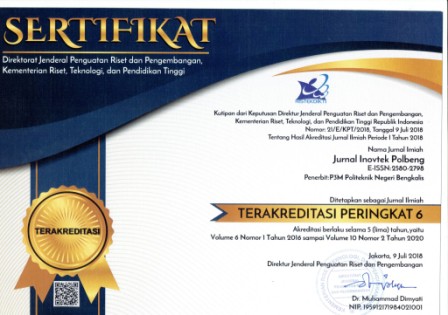Pengaruh jarak susun lapisan penguat Komposit Serat Daun Nanas / Termoplastik pada Pembentukan Delaminasi
Abstract
Penelitian ini bertujuan untuk mengetahui pengaruh posisi jarak serat penguat dalam laminasi komposit pada pembentukan delaminasi. jarak serat penguat yang dipilih adalah 1 mm, 2 mm dan 3 mm dalam laminasi komposit dari matriks polimer etilen vinil asetat (EVA) dengan serat penguat dari daun nanas. Metode yang digunakan dalam fabrikasi komposit adalah hand lay-up, yaitu dengan pengecoran langsung pada tiga lapisan serat yang telah dianyam dan diikat ke sisi cetakan. Untuk kecepatan potong, Vf 144 mm / min, menggunakan pahat bor berdiameter 4 mm dengan sudut pahat 70o. Delaminasi ditentukan dengan metode Feda. Bagian delaminasi diamati menggunakan mikroskop digital dan kemudian diproses menggunakan AutoCAD untuk mengukur Dmax dan Ad. Rasio delaminasi pada lubang atas untuk jarak 1 mm, 2 mm dan 3 mm masing-masing adalah 1,417, 1,362 dan 1,324 untuk lubang bawah adalah 1,114, 1,098 dan 1,076.                                Â
Kata kunci: Delaminasi; komposit laminasi; etilena vinil asetat; serat daun nanas; proses penggurdian.
Keywords
Full Text:
PDFReferences
F. Hussain, M. Hojjati, M. Okamoto, and R. E. Gorga, “Polymer-matrix nanocomposites, processing, manufacturing, and application: An overview,†J. Compos. Mater., vol. 40, no. 17, pp. 1511–1575, 2006.
K. L. Pickering, M. G. A. Efendy, and T. M. Le, “A review of recent developments in natural fibre composites and their mechanical performance,†Compos. Part A Appl. Sci. Manuf., vol. 83, pp. 98–112, 2016.
M. Asrofi, H. Abral, Y. K. Putra, S. M. Sapuan, and H. J. Kim, “Effect of duration of sonication during gelatinization on properties of tapioca starch water hyacinth fiber biocomposite,†Int. J. Biol. Macromol., vol. 108, pp. 167–176, 2018.
H. Abral, G. J. Putra, M. Asrofi, J.-W. Park, and H.-J. Kim, “Effect of vibration duration of high ultrasound applied to bio-composite while gelatinized on its properties,†Ultrason. Sonochem., vol. 40, 2018.
R. A. Ilyas, S. M. Sapuan, M. R. Ishak, and E. S. Zainudin, “Development and characterization of sugar palm nanocrystalline cellulose reinforced sugar palm starch bionanocomposites,†Carbohydr. Polym., vol. 202, pp. 186–202, 2018.
E. Syafri et al., “Synthesis and characterization of cellulose nanofibers (CNF) ramie reinforced cassava starch hybrid composites,†Int. J. Biol. Macromol., vol. 120, pp. 578–586, 2018.
K. Z. M. A. Motaleb, M. S. Islam, and M. B. Hoque, “Improvement of Physicomechanical Properties of Pineapple Leaf Fiber Reinforced Composite,†Int. J. Biomater., vol. 2018, 2018.
M. Asim et al., “A Review on Pineapple Leaves Fibre and Its Composites,†Int. J. Polym. Sci., vol. 2015, pp. 1–16, 2015.
H. Abral et al., “Mechanical properties of water hyacinth fibers - polyester composites before and after immersion in water,†Mater. Des., vol. 58, pp. 125–129, 2014.
D. F. Liu, Y. J. Tang, and W. L. Cong, “A review of mechanical drilling for composite laminates,†Compos. Struct., vol. 94, no. 4, pp. 1265–1279, 2012.
S. Al-wandi, S. Ding, and J. Mo, “An approach to evaluate delamination factor when drilling carbon fiber-reinforced plastics using different drill geometries: experiment and finite element study,†Int. J. Adv. Manuf. Technol., vol. 93, no. 9–12, pp. 4043–4061, 2017.
Y. Turki, M. Habak, R. Velasco, Z. Aboura, K. Khellil, and P. Vantomme, “Experimental investigation of drilling damage and stitching effects on the mechanical behavior of carbon/epoxy composites,†Int. J. Mach. Tools Manuf., vol. 87, pp. 61–72, 2014.
K. Debnath, I. Singh, and A. Dvivedi, “Drilling characteristics of sisal fiber-reinforced epoxy and polypropylene composites,†Mater. Manuf. Process., vol. 29, no. 11–12, pp. 1401–1409, 2014.
DOI: https://doi.org/10.35314/ip.v10i1.1284
Refbacks
- TT789
- jawa88
- Raja 88
- slot
- Svip5
- ladang78 login
- janjigacor login
- Jawa88
- rejekibet
- raja88 slot
- jayaslot
- Ladang78
- apk slot
- mega77
- Ladang78
- slot gacor 777
- vm777
- toto slot
- slot
Copyright (c) 2020 INOVTEK POLBENG
This Journal has been listed and indexed in :

inovtek polbeng by http://ejournal.polbeng.ac.id/index.php/IP is licensed under a Creative Commons Attribution-ShareAlike 4.0 International License









